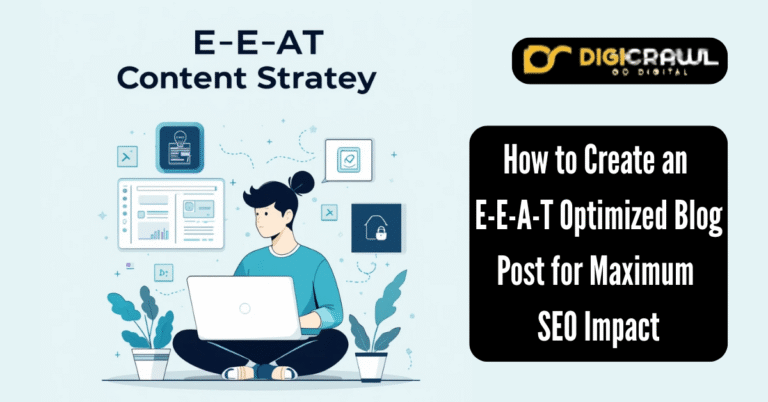The Ultimate Comprehensive Approach Towards SEO Optimization
SEO stands for Search Engine Optimization. It is a set of practices and techniques aimed at improving a website’s visibility and ranking in search engine results pages (SERPs) like Google, Bing and Yahoo and also an important part of Digital Marketing Services.
Table of Contents
ToggleIt is not just about increasing traffic flow but Increasing web traffic that converts into sales or leads. SEO is like solving a puzzle with different pieces like on-page SEO, off-page SEO and technical SEO.
Suppose you want to boost your website’s visibility; this article will help you understand how a Comprehensive Approach Towards SEO Optimization can ensure your website is fully optimized for all the required SEO practices.
You should like to read: Do’s And Don’ts Of Hiring An SEO Agency
The Importance of SEO
SEO is important for any website because it helps improve its visibility and ranking on search engines like Google. Using a Comprehensive Approach Towards SEO Optimization ensures that your website meets all the search engine optimization requirements.
“93% of online experiences begin with a search engine.“ Search Engine Journal
When done right SEO makes it easier for search engines to find and understand your content which helps your website appear higher in search results. This means more people can find your site increasing traffic and potential customers.
Comprehensive SEO Approach 2024
A Comprehensive SEO Approach is more important than ever to improve your website’s visibility and performance. You can monitor your website’s traffic and fix errors by following key steps.
- setting up Google Search Console
- Set Up Google Analytics to track your site’s progress.
- Installing an SEO plugin
- Creating and submitting a sitemap
- Robots.txt file helps control which pages to be indexed and which pages to be removed
Finally, ensuring your site is fully indexable allows search engines to access and rank all your pages. These simple yet essential SEO practices are vital for boosting your website’s ranking.
1. On-Page SEO Checklist
On-page SEO also called on-site SEO is optimizing each page on your website to improve its ranking and attract more relevant traffic. It is a critical part of SEO strategy. Here is a simple on-page SEO checklist to help you optimize your website effectively.
Select Primary and Secondary Keywords
Start by selecting your focus (Primary keyword ) the main words or phrases you want to rank for. These should be relevant to your business and your audience. In addition to focus keywords use secondary ( Supportive keywords ).
These are related phrases that help expand your content reach. For example, if your focus keyword is ” How To Get High Quality Backlinks ” your secondary keywords could be “Building Quality Backlinks” or “Create Powerful Backlinks “.
Research Your Competitors Keyword Profiles
Studying your competitors is a key part of the on-page SEO practices. Check out what keywords they rank for. This can help you find gaps where you can target keywords they are missing. Tools like Ubersuggest , Semrush and Ahrefs make it easy to analyze your competitors’ keyword profiles.
Search Intent for Your Target Audience
To rank well you need to understand search intent why people search for specific terms. Are they looking for information, products or solutions? You will meet user needs and improve local SEO performance by matching your content to search intent.
Build Strong Internal linking
Internal linking helps both users and search engines navigate your website. It passes SEO value from one page to another improving your page’s ranking potential. Ensure you link relevant pages together naturally using relevant anchor text so users stay on your site longer.
Check Duplicate Content and Keyword Cannibalization
Search engines dislike duplicate content. It confuses them and can lower your ranking. Ensure each page has unique content and does not target the same keyword multiple times a problem known as keyword cannibalization.
Build Around E-E-A-T
E-E-A-T stands for Experience, Expertise, Authoritativeness and Trustworthiness. Search engines favor websites that show they have strong credibility in their field, Provide valuable and accurate information to demonstrate expertise on your website to improve trustworthiness.
Add Meta Data And Image Tags
Title tags and meta descriptions are important for SEO. These short texts appear in search engine results and give users an idea of what your page is about.
Your meta description should include the focus keyword and be around 155 characters long. Also, do not forget to add image alt tags that describe what your images are about helping search engines understand your content better.
Create a Descriptive URL
URL should be simple, clean and include your focus keyword. Avoid long and complicated URLs filled with numbers or irrelevant characters. For example, “www.example.com/on-page-seo-checklist” is better than “www.example.com/abc123456” and also focus on navigation path optimization of websites that will help to crawl your website’s pages.
Optimize Header Tags
H1 tag is the main heading on the page. It should briefly explain your page and include your focus keyword. A good H1 helps both users and search engines understand the content of your page.
Use H2 and H3 tags to organize your content into sections. These make your content easier to read for the users and for better understanding of crawler. Each subheading should be descriptive and when appropriate, include secondary.
2. SEO-Friendly Content Creation
Creating SEO friendly content is essential for improving your website’s organic traffic and attracting more visitors. This process involves researching high volume, low competition keywords and integrating them naturally into your content while ensuring it aligns with the user’s intent.
You can boost your website’s ranking and build topical authority in your niche by delivering high quality optimized content that is easy to read and provides valuable information. Effective content creation also means using alt tags for images, improving overall accessibility and helping search engines better understand your content.
“The average first-page result on Google has 1,447 words.” Backlinko
3. Technical SEO Checklist
Technical SEO Checklist helps ensure your website meets search engine standards for optimal performance. Following are critical factors of technical SEO.
Page Loading Speeds
Fast page loading speeds are crucial for both user experience and SEO rankings. Visitors are more likely to leave if your website takes more time to load which can increase bounce rates and hurt your search engine performance.
To optimize speed, compress images, enable caching and consider switching to a faster hosting provider. Use tools like Google PageSpeed Insights to regularly monitor and improve your site’s loading times.
Ensure Your Pages Meet Core Web Vitals
Meeting Core Web Vitals (CWV) is essential for a great user experience and improved SEO performance. These metrics measure important aspects like loading speed, interactivity and visual stability.
By optimizing your site to meet these standards you can boost your rankings and ensure a smooth experience for users.
Schema Markup to Target Rich Snippets
Implementing schema markup is a key tactic in technical SEO as it helps search engines better understand your content.
Using schema increases your chances of appearing in rich snippets which can attract more clicks and improve your site’s visibility. Rich snippets provide extra information like reviews, prices or FAQs making your listing stand out from competitors.
Website Is Mobile Friendly
A mobile friendly website is a must in today’s mobile driven world. Google prioritizes mobile first indexing which means the mobile version of your site is used for indexing and ranking.
To ensure your site is optimized for mobile users use responsive design, compress images and test your site on multiple devices.
“About 53% of mobile site visits are abandoned if a page takes longer than three seconds to load.” Google
Check for 404 Errors
Broken links and 404 errors can harm user experience and SEO performance. Regularly check your site for these errors using tools like Screaming Frog or Google Search Console.
If you find a 404 error then fix the link or set up a 301 redirect to guide users to the correct page. A smooth user experience will help maintain your rankings and reduce bounce rates.
4. Local SEO Checklist
A local SEO is essential for businesses aiming to attract local customers and improve online visibility in the proximity. Here are the steps that we should consider.
Build A Google Business Profile Page ( Previously BMB )
Creating a Google Business Profile (GBP) is the first step in your local SEO strategy. A GBP helps local customers find your business, learn about your services and contact you easily. This profile also improves your visibility in local search results.
To set up a GBP go to Google Map click “Manage Now” and enter your business information. A GBP puts you on the map making you more competitive in your local area.
Submit Your Site to Online Business Directories
Listing your business in online business directories is an effective way to improve your local SEO. Directories like Facebook, Apple Maps, Bing Places and Yelp allow potential customers to find you easily.
Submitting your business to high domain authority directories also helps gain valuable backlinks which boost your SEO rankings.
Consistent of NAP Across All Platforms
Consistency is key in local SEO. Ensure your NAP (Name, Address and Phone number) is the same on every website page and across all directories and social media platforms.
This consistency helps search engines correctly associate your business with its physical location which improves your local rankings. Additionally consistent information builds trust with customers helping to enhance your business’s credibility.
Make Relevant Business Information
Your website should have all the important details such as your business name, address, phone number, opening hours and a contact form. Including this information on every website page not just the homepage is a good idea.
Many visitors may land on different pages of your site through search engines and having all the necessary information available ensures they can easily find and contact you. Including a map can also help visitors locate your business easily.
5. Off-Page SEO Techniques
Link building is crucial for enhancing your website’s authority and visibility beyond your site. These techniques focus on building quality backlinks profile of your website.
Create a Link Building Strategy
A solid link building strategy is key to off-page SEO success. You can start by researching websites that may want to link to your content.
Creating high quality content such as guides, infographics and blogs that provide useful information can naturally attract backlinks. Reaching out to website owners or other content creators can also help you gain backlinks.
“Businesses that blog receive 97% more links to their websites.“ HubSpot
Build Contextual And Quality Backlinks
One of the most important off-page SEO techniques is creating backlinks from reputable websites. Backlinks are like votes of confidence from other sites telling search engines that your content is valuable and trustworthy.
The more high quality backlinks you have the more your website’s authority and rankings will improve.
“ 96% of sites in Google’s top 10 positions have 1,000+ links from unique domains ” Search Engine Land
Guest Posting on Authoritative Websites
Guest posting is an excellent way to gain backlinks and increase brand visibility. By writing articles for websites with high domain authority you get exposure to a new audience and improve your website’s rankings.
Ensure the sites you guest post on are related to your industry to get the most value from your backlinks.
Social Media Engagement
Although not a direct ranking factor, social media signals can still boost your website’s visibility and authority. Sharing your content on platforms like Facebook, Twitter and LinkedIn can increase its reach potentially leading to more backlinks and traffic to your site.
Engaging with your audience on social media also helps build brand awareness. Monitoring these factors lets you see what’s working and where improvements can be made.
SEO Pitfalls to Avoid
When optimizing your website it is important to avoid certain SEO mistakes that can lead to penalties from search engines. Following the right practices will help improve your site’s ranking but some mistakes can hurt your website’s visibility. Here are some of the most common SEO pitfalls you should stay away from:
“SEO is not about gaming the system anymore; it’s about learning how to play by the rules.” Jordan Teicher
Keyword Stuffing
Keyword stuffing is when you overload a web page with too many keywords to try and trick search engines into ranking it higher. This not only makes the content hard to read but can also result in lower rankings. Instead of stuffing keywords, focus on creating quality content that is relevant to your audience and naturally includes keywords.
Cloaking
Cloaking is when a website shows different content to search engines than what it shows to users. This is a deceptive practice that can lead to severe penalties. Always present the same content to users and search engines to ensure your website follows ethical SEO practices.
Buying Links (Paid Links)
Some websites try to improve their rankings by purchasing links from other sites known as paid links. This violates Google’s guidelines and can result in harsh penalties. Instead of buying links, create valuable content that earns natural backlinks from reputable websites.
Link Farms
A link farm is a group of websites linking to each other to boost rankings. This is a practice that Google opposes and can lead to penalization. Focus on building natural and quality links from trustworthy sources instead of relying on link farms.
In conclusion, we hope you have enjoyed reading this guidance and beleive that a comprehensive approach to SEO optimization involves the following
- Using both on-page and off-page strategies.
- Focusing on technical health.
- Consistently creating high quality content.
Remember, SEO is not a one time task but an ongoing process that requires regular updates and adjustments to stay ahead of changing trends and algorithms. With patience and consistent effort your website will see long term success.
Want to see your website in the top ranking?
Contact DIGICRAWL for the rapid growth of your business. We have a result-driven SEO Services in Islamabad to rank out your competitors.







